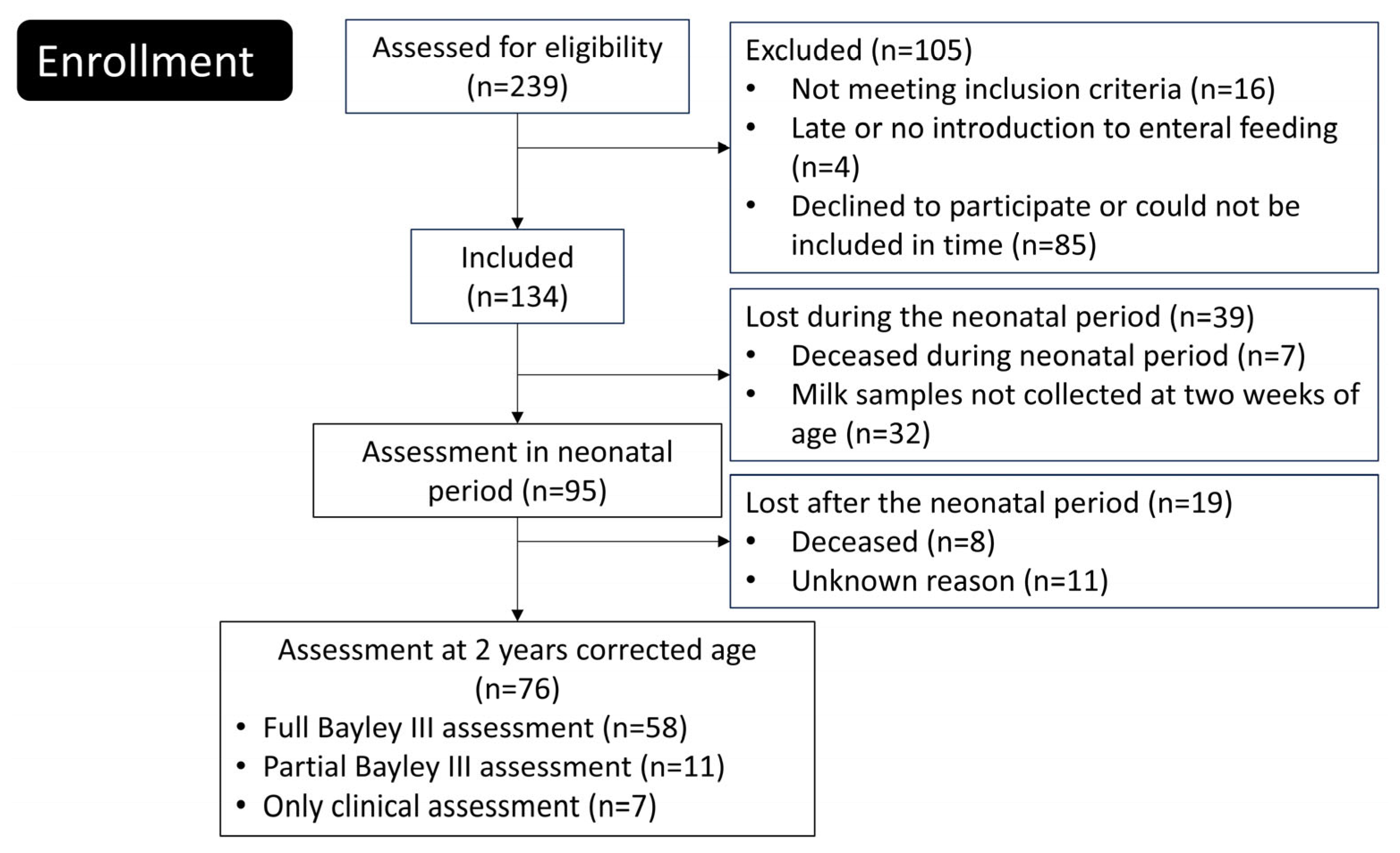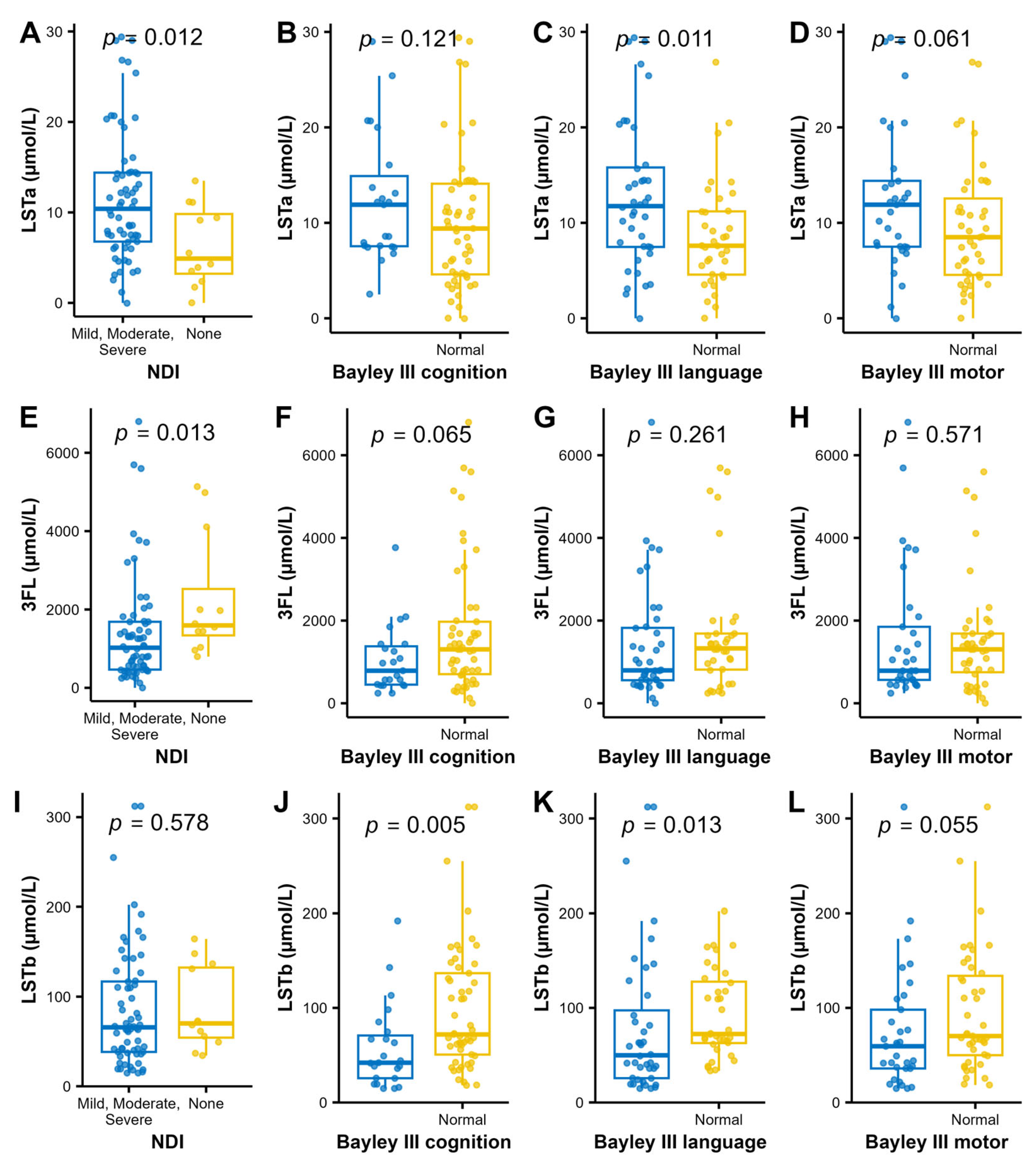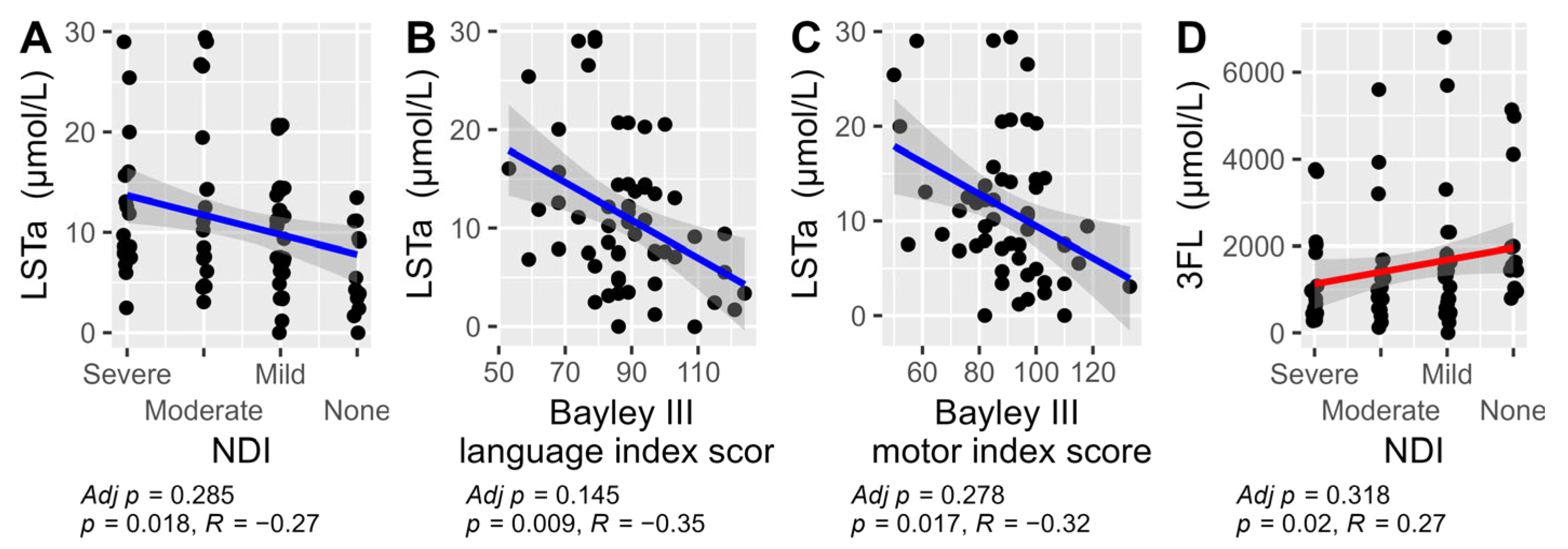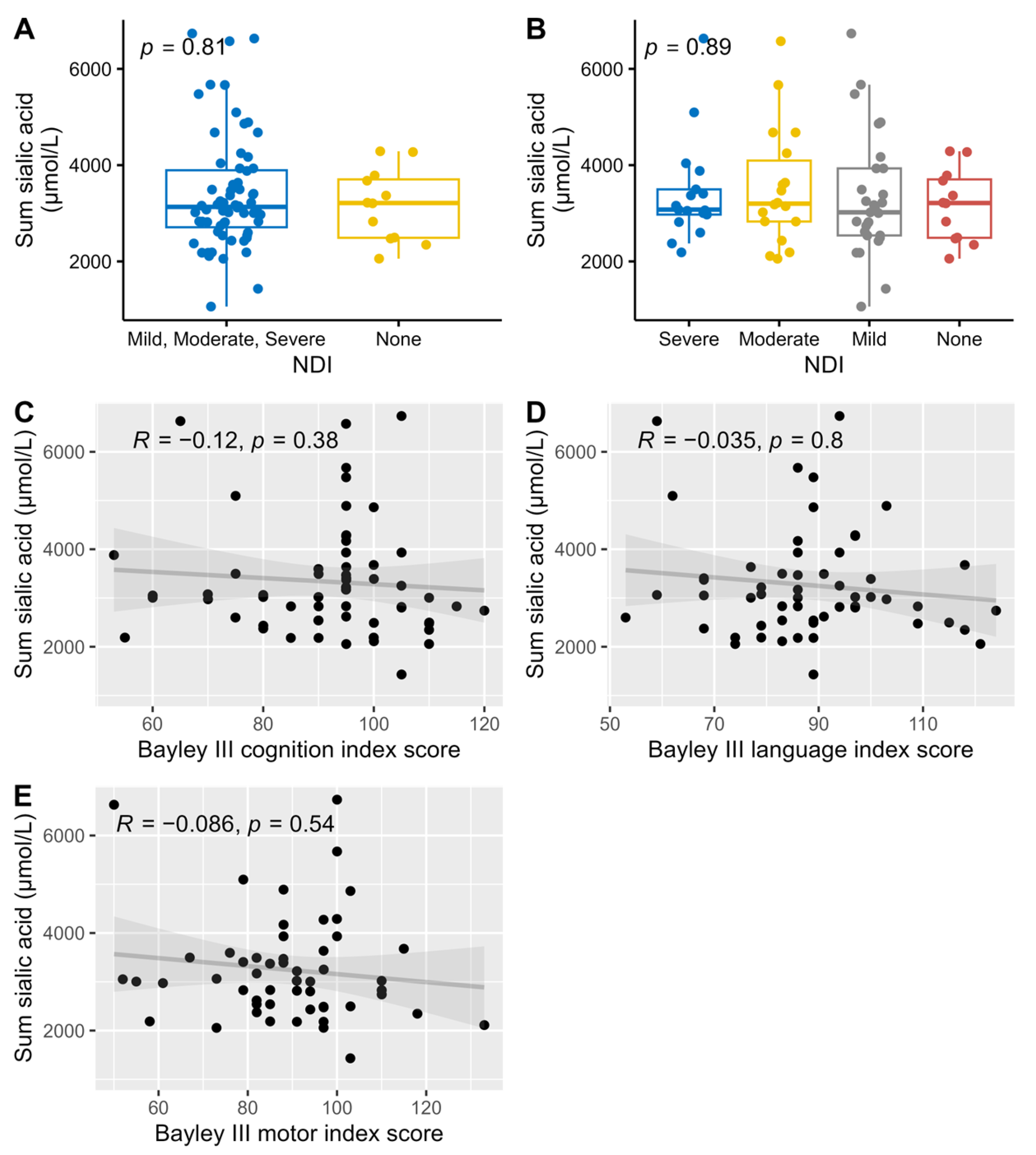Human Milk Oligosaccharides in Breast Milk at Two Weeks of Age in Relation to Neurodevelopment in 2-Year-Old Children Born Extremely Preterm: An Explorative Trial
Abstract
1. Introduction
2. Materials and Methods
2.1. Participants
2.2. HMO Sampling and Analysis
2.3. Neurodevelopmental Outcome Assessment
2.4. Ethics
2.5. Statistical Analysis
3. Results
4. Discussion
Strengths and Limitations
5. Conclusions
Supplementary Materials
Author Contributions
Funding
Institutional Review Board Statement
Informed Consent Statement
Data Availability Statement
Acknowledgments
Conflicts of Interest
References
- Hickey, L.; Burnett, A.; Spittle, A.J.; Roberts, G.; Anderson, P.; Lee, K.; Doyle, L.W.; Cheong, J.L.Y. Extreme prematurity, growth and neurodevelopment at 8 years: A cohort study. Arch. Dis. Child. 2021, 106, 160–166. [Google Scholar] [CrossRef] [PubMed]
- Norman, M.; Hallberg, B.; Abrahamsson, T.; Björklund, L.J.; Domellöf, M.; Farooqi, A.; Foyn Bruun, C.; Gadsboll, C.; Hellström-Westas, L.; Ingemansson, F.; et al. Association Between Year of Birth and 1-Year Survival Among Extremely Preterm Infants in Sweden During 2004–2007 and 2014–2016. JAMA J. Am. Med. Assoc. 2019, 321, 1188–1199. [Google Scholar] [CrossRef] [PubMed]
- Serenius, F.; Källén, K.; Blennow, M.; Ewald, U.; Fellman, V.; Holmström, G.; Lindberg, E.; Lundqvist, P.; Maršál, K.; Norman, M.; et al. Neurodevelopmental outcome in extremely preterm infants at 2.5 years after active perinatal care in Sweden. JAMA 2013, 309, 1810–1820. [Google Scholar] [CrossRef] [PubMed]
- Morsing, E.; Lundgren, P.; Hard, A.L.; Rakow, A.; Hellstrom-Westas, L.; Jacobson, L.; Johnson, M.; Nilsson, S.; Smith, L.E.H.; Savman, K.; et al. Neurodevelopmental disorders and somatic diagnoses in a national cohort of children born before 24 weeks of gestation. Acta Paediatr. 2022, 111, 1167–1175. [Google Scholar] [CrossRef]
- Padilla, N.; Alexandrou, G.; Blennow, M.; Lagercrantz, H.; Åden, U. Brain Growth Gains and Losses in Extremely Preterm Infants at Term. Cereb. Cortex 2015, 25, 1897–1905. [Google Scholar] [CrossRef]
- Kvanta, H.; Padilla, N.; Nosko, D.; Martensson, G.; Brostrom, L.; de Gamarra-Oca, L.F.; Bolk, J.; Aden, U. Brain volumes and cortical thickness and associations with cognition in children born extremely preterm. Pediatr. Res. 2024. [Google Scholar] [CrossRef]
- Keunen, K.; van Elburg, R.M.; van Bel, F.; Benders, M.J. Impact of nutrition on brain development and its neuroprotective implications following preterm birth. Pediatr. Res. 2015, 77, 148–155. [Google Scholar] [CrossRef]
- Belfort, M.B.; Anderson, P.J.; Nowak, V.A.; Lee, K.J.; Molesworth, C.; Thompson, D.K.; Doyle, L.W.; Inder, T.E. Breast Milk Feeding, Brain Development, and Neurocognitive Outcomes: A 7-Year Longitudinal Study in Infants Born at Less Than 30 Weeks’ Gestation. J. Pediatr. 2016, 177, 133–139.e1. [Google Scholar] [CrossRef]
- Belfort, M.B.; Inder, T.E. Human Milk and Preterm Infant Brain Development: A Narrative Review. Clin. Ther. 2022, 44, 612–621. [Google Scholar] [CrossRef]
- Belfort, M.B.; Knight, E.; Chandarana, S.; Ikem, E.; Gould, J.F.; Collins, C.T.; Makrides, M.; Gibson, R.A.; Anderson, P.J.; Simmer, K.; et al. Associations of Maternal Milk Feeding With Neurodevelopmental Outcomes at 7 Years of Age in Former Preterm Infants. JAMA Netw. Open 2022, 5, e2221608. [Google Scholar] [CrossRef]
- Ottolini, K.M.; Andescavage, N.; Kapse, K.; Jacobs, M.; Limperopoulos, C. Improved brain growth and microstructural development in breast milk-fed very low birth weight premature infants. Acta Paediatr. 2020, 109, 1580–1587. [Google Scholar] [CrossRef] [PubMed]
- Peila, C.; Riboldi, L.; Coscia, A. Role of the biological active components of human milk on long-term growth and neurodevelopmental outcome. Ital. J. Pediatr. 2024, 50, 201. [Google Scholar] [CrossRef] [PubMed]
- Bode, L. Human milk oligosaccharides: Every baby needs a sugar mama. Glycobiology 2012, 22, 1147–1162. [Google Scholar] [CrossRef] [PubMed]
- McGuire, M.K.; Meehan, C.L.; McGuire, M.A.; Williams, J.E.; Foster, J.; Sellen, D.W.; Kamau-Mbuthia, E.W.; Kamundia, E.W.; Mbugua, S.; Moore, S.E.; et al. What’s normal? Oligosaccharide concentrations and profiles in milk produced by healthy women vary geographically. Am. J. Clin. Nutr. 2017, 105, 1086–1100. [Google Scholar] [CrossRef]
- Manthey, C.F.; Autran, C.A.; Eckmann, L.; Bode, L. Human milk oligosaccharides protect against enteropathogenic Escherichia coli attachment in vitro and EPEC colonization in suckling mice. J. Pediatr. Gastroenterol. Nutr. 2014, 58, 165–168. [Google Scholar] [CrossRef]
- Tarr, A.J.; Galley, J.D.; Fisher, S.E.; Chichlowski, M.; Berg, B.M.; Bailey, M.T. The prebiotics 3’Sialyllactose and 6’Sialyllactose diminish stressor-induced anxiety-like behavior and colonic microbiota alterations: Evidence for effects on the gut-brain axis. Brain Behav. Immun. 2015, 50, 166–177. [Google Scholar] [CrossRef]
- Wang, B. Molecular mechanism underlying sialic acid as an essential nutrient for brain development and cognition. Adv. Nutr. 2012, 3, 465s–472s. [Google Scholar] [CrossRef]
- Cho, S.; Zhu, Z.; Li, T.; Baluyot, K.; Howell, B.R.; Hazlett, H.C.; Elison, J.T.; Hauser, J.; Sprenger, N.; Wu, D.; et al. Human milk 3’-Sialyllactose is positively associated with language development during infancy. Am. J. Clin. Nutr. 2021, 114, 588–597. [Google Scholar] [CrossRef]
- Berger, P.K.; Plows, J.F.; Jones, R.B.; Alderete, T.L.; Yonemitsu, C.; Poulsen, M.; Ryoo, J.H.; Peterson, B.S.; Bode, L.; Goran, M.I. Human milk oligosaccharide 2′-fucosyllactose links feedings at 1 month to cognitive development at 24 months in infants of normal and overweight mothers. PLoS ONE 2020, 15, e0228323. [Google Scholar] [CrossRef]
- Jorgensen, J.M.; Young, R.; Ashorn, P.; Ashorn, U.; Chaima, D.; Davis, J.C.C.; Goonatilleke, E.; Kumwenda, C.; Lebrilla, C.B.; Maleta, K.; et al. Associations of human milk oligosaccharides and bioactive proteins with infant growth and development among Malawian mother-infant dyads. Am. J. Clin. Nutr. 2021, 113, 209–220. [Google Scholar] [CrossRef]
- Wejryd, E.; Marti, M.; Marchini, G.; Werme, A.; Jonsson, B.; Landberg, E.; Abrahamsson, T.R. Low Diversity of Human Milk Oligosaccharides is Associated with Necrotising Enterocolitis in Extremely Low Birth Weight Infants. Nutrients 2018, 10, 1556. [Google Scholar] [CrossRef] [PubMed]
- Neonatalföreningen, S. Nationella Riktlinjer för Uppföljning av Neonatala Riskbarn. National Guidlines from the Swedish Society for Neonatology. Available online: https://neo.barnlakarforeningen.se/wp-content/uploads/sites/14/2014/03/Nationella-Uppfoljningsprogrammet-2015.pdf (accessed on 16 March 2015).
- Bayley, N. Bayley Scales of Infant and Toddler Development, 3rd ed.; Harcourt Assessment Inc: San Antonio, TX, USA, 2006. [Google Scholar]
- Berger, P.K.; Bansal, R.; Sawardekar, S.; Yonemitsu, C.; Furst, A.; Hampson, H.E.; Schmidt, K.A.; Alderete, T.L.; Bode, L.; Goran, M.I.; et al. Associations of Human Milk Oligosaccharides with Infant Brain Tissue Organization and Regional Blood Flow at 1 Month of Age. Nutrients 2022, 14, 3820. [Google Scholar] [CrossRef] [PubMed]
- Pisa, E.; Martire, A.; Chiodi, V.; Traversa, A.; Caputo, V.; Hauser, J.; Macri, S. Exposure to 3’Sialyllactose-Poor Milk during Lactation Impairs Cognitive Capabilities in Adulthood. Nutrients 2021, 13, 4191. [Google Scholar] [CrossRef]
- Gabrielli, O.; Zampini, L.; Galeazzi, T.; Padella, L.; Santoro, L.; Peila, C.; Giuliani, F.; Bertino, E.; Fabris, C.; Coppa, G.V. Preterm milk oligosaccharides during the first month of lactation. Pediatrics 2011, 128, e1520–e1531. [Google Scholar] [CrossRef]
- Tonon, K.M.; de Morais, M.B.; Abrão, A.C.F.V.; Miranda, A.; Morais, T.B. Maternal and Infant Factors Associated with Human Milk Oligosaccharides Concentrations According to Secretor and Lewis Phenotypes. Nutrients 2019, 11, 1358. [Google Scholar] [CrossRef]







| Name | Type | Secreted by | Neurodevelopmental Impairment | |||||
|---|---|---|---|---|---|---|---|---|
| None N = 12 1 | Mild N = 29 1 | Moderate N = 18 1 | Severe N = 17 1 | p-Value 2 | q-Value 3 | |||
| 3′-sialyllactose (3SL) | Sialylated | All | 306 (249–386) | 286 (256–352) | 383 (296–444) | 331 (236–357) | 0.20 | >0.90 |
| 6′-sialyllactose (6SL) | Sialylated | All | 1203 (1000–1490) | 1174 (869–1442) | 947 (814–1430) | 1368 (1076–1653) | 0.30 | >0.90 |
| Sialyl-lacto-N-tetraose a (LSTa) | Sialylated | All | 5 (3–10) | 11 (6–14) | 11 (6–18) | 10 (8–16) | 0.065 | >0.90 |
| Sialyl-lacto-N-tetraose b (LSTb) | Sialylated | All | 70 (54–133) | 67 (36–109) | 83 (60–117) | 44 (33–113) | 0.40 | >0.90 |
| Sialyl-lacto-N-neotetraose c (LSTc) | Sialylated | All | 127 (86–200) | 127 (88–150) | 148 (59–200) | 146 (73–182) | >0.90 | >0.90 |
| Disialyl-lacto-N-tetraose (DSLNT) | Sialylated | All | 594 (564–746) | 673 (457–1070) | 715 (542–1017) | 572 (414–942) | 0.60 | >0.90 |
| 2′-fucosyllactose (2FL) | Neutral | Se+ | 4689 (2608–6290) | 5844 (4436–7661) | 6105 (4027–7654) | 6266 (0–8026) | 0.50 | >0.90 |
| 3′-fucosyllactose (3FL) | Neutral | All | 1594 (1339–2524) | 1282 (571–1638) | 1153 (620–1622) | 669 (427–1850) | 0.063 | >0.90 |
| Lacto-difucotetraose (LDFT) | Neutral | Se+ | 445 (287–604) | 442 (298–684) | 504 (299–928) | 279 (0–697) | 0.50 | >0.90 |
| Lacto-N-tetraose (LNT) | Neutral | All | 2230 (1780–2365) | 1752 (1252–2704) | 2489 (2129–2964) | 2388 (1425–3508) | 0.20 | >0.90 |
| Lacto-N-neotetraose (LNnT) | Neutral | All | 133 (50–238) | 205 (134–257) | 238 (148–396) | 143 (111–214) | 0.082 | >0.90 |
| Lacto-N-fucopentaose I (LNFP I) | Neutral | Se+ | 613 (315–1156) | 1203 (640–1598) | 1727 (910–2213) | 1208 (0–2572) | 0.13 | >0.90 |
| Lacto-N-fucopentaose II (LNFP II) | Neutral | Le+ | 644 (359–767) | 367 (124–693) | 423 (280–967) | 266 (0–620) | 0.30 | >0.90 |
| Lacto-N-fucopentaose III (LNFP III) | Neutral | All | 349 (310–438) | 363 (296–551) | 448 (250–550) | 346 (218–436) | 0.70 | >0.90 |
| Lacto-N-difucohexaose I (LNDH I) | Neutral | Se+ Le+ | 942 (318–1094) | 840 (0–1166) | 1269 (252–1555) | 0 (0–972) | 0.033 | 0.50 |
| Σ analyzed HMO | 15,527 (12,043–16,619) | 15,321 (13,008–16,869) | 16,913 (14,705–19,860) | 15,746 (12,998–16,829) | 0.30 | >0.90 | ||
| Developmental Domain | Neurological Developmental Impairment | |||
|---|---|---|---|---|
| None (0) | Mild (1) | Moderate (2) | Severe (3) | |
| Cognition or language | ||||
| Bayley III cognitive scales | Bayley III Scores > −1 SD (Index ≥ 95) | Bayley III Scores −1 SD to −2 SD (Index 83–94) | Bayley III Scores −2 SD to −3 SD (Index 72–82) | Bayley III Scores < −3 SD (Index < 72) |
| Bayley III language scales | Bayley III Scores > −1 SD (Index ≥ 97) | Bayley III Scores −1 SD to −2 SD (Index 85–96) | Bayley III Scores −2 SD to −3 SD (Index 72–84) | Bayley III Scores < −3 SD (Index < 72) |
| Parent report | Speech: Uses sentences with 2–3 words | Speech: Says a few words (vocabulary > 10 words) | Speech: Says a few words (vocabulary < 10 words) | Speech: Does not speak at all |
| or Motor function | ||||
| Cerebral palsy (Gross motor function classification scale) | None | 1 | 2–3 | 4–5 (non-ambulant) |
| Bayley III fine and gross motor scales | > −1 SD (Index ≥ 94) | Scores −1 SD to −2 SD (Index 80–93) | Scores −2 SD to −3 SD (Index 66–79) | Scores < −3 SD (Index < 66) |
| Doctor’s report | Normal head control Sits without support Walks without support Normal finger movements | Fine motor function: Clumsy but can grasp or Abnormal neurology or motor development | Fine motor function: Clumsy but can grasp | Unsteady head control Unsteady sitting or cannot sit. Fine motor: Does not grasp objects. |
| or Hearing | ||||
| Parent report | No hearing impairment | No hearing impairment | Hearing impairment or Has hearing aids but still impaired hearing | Cannot hear |
| or Vision | ||||
| Parent report | No visual impairment | Visual impairment: No impairment when wearing glasses | Visual impairment: Serious visual impairment that remains in spite of glasses or Admitted to center for visual impairments | Visual impairment: Bilateral blindness |
| Neurological Developmental Impairment | |||||
|---|---|---|---|---|---|
| Characteristic | None, N = 12 1 | Mild, N = 29 1 | Moderate, N = 18 1 | Severe, N = 17 1 | p-Value |
| Perinatal data | |||||
| Gestational age, weeks | 25.9 (25.2–25.9) | 26.3 (25.1–26.6) | 24.6 (23.9–25.6) | 25.1 (24.3–25.9) | 0.028 2 |
| Birth weight, g | 789 (677–932) | 803 (686–906) | 676 (601–807) | 696 (631–817) | 0.033 2 |
| Birth weight z-score | −0.5 (−1.6–0.0) | −0.7 (−1.1–−0.4) | −0.7 (−1.3–−0.4) | −0.6 (−1.5–−0.2) | >0.90 2 |
| Birth length z-score | −0.9 (−1.6–−0.3) | −0.7 (−1.8–0.4) | −1.3 (−2.5–−0.5) | −0.7 (−2.0–−0.4) | 0.40 2 |
| Birth head circumference z-score | −0.4 (−0.9–0.1) | −0.8 (−1.3–−0.4) | −0.6 (−1.0–−0.3) | −0.7 (−1.3–−0.2) | 0.50 2 |
| Apgar at 5 min 5 | 7.5 (5.8–9.0) | 7.0 (4.0–8.0) | 6.0 (4.0–7.0) | 5.0 (3.8–7.3) | 0.30 2 |
| Apgar at 10 min 5 | 8.5 (7.8–9.3) | 8.0 (7.0–9.0) | 8.0 (7.0–8.8) | 8.0 (7.0–9.0) | 0.50 2 |
| Small for gestational age | 2 (17%) | 7 (24%) | 2 (11%) | 3 (18%) | 0.70 3 |
| Female sex | 6 (50%) | 13 (45%) | 7 (39%) | 6 (35%) | 0.90 4 |
| Infants from multiple pregnancy | 3 (25%) | 12 (41%) | 6 (33%) | 5 (29%) | 0.80 3 |
| Chorioamnionitis | 2 (17%) | 7 (24%) | 3 (17%) | 3 (18%) | >0.90 3 |
| Caesarean section | 6 (50%) | 18 (62%) | 11 (61%) | 10 (59%) | >0.90 3 |
| Maternal smoking at inclusion | 1 (8.3%) | 0 (0%) | 1 (5.6%) | 0 (0%) | 0.30 3 |
| Prenatal steroids administered | 11 (92%) | 28 (97%) | 18 (100%) | 17 (100%) | 0.50 3 |
| Inclusion site | 0.093 3 | ||||
| Linköping | 2 (17%) | 7 (24%) | 10 (56%) | 6 (35%) | |
| Stockholm | 10 (83%) | 22 (76%) | 8 (44%) | 11 (65%) | |
| Neonatal complications | |||||
| Sepsis, culture positive | 3 (25%) | 9 (31%) | 4 (22%) | 9 (53%) | 0.30 3 |
| Intracerebral hemorrhage, grade 3–4 | 0 (0%) | 3 (10%) | 3 (17%) | 5 (29%) | 0.20 3 |
| Periventricular leukomalacia | 0 (0%) | 1 (3.4%) | 1 (5.6%) | 2 (12%) | 0.603 |
| Necrotizing enterocolitis, grade II-III | 0 (0%) | 2 (6.9%) | 0 (0%) | 5 (29%) | 0.014 3 |
| Days in ventilator, total | 7 (2–14) | 6 (0–18) | 31 (10–34) | 21 (18–32) | <0.001 2 |
| Bronchopulmonary dysplasia | 4 (33%) | 14 (48%) | 13 (72%) | 13 (76%) | 0.046 4 |
| Family | |||||
| Postgraduate parents, number of | 0.14 3 | ||||
| 0 | 2 (17%) | 4 (14%) | 4 (22%) | 7 (41%) | |
| 1 | 3 (25%) | 1 (3.4%) | 0 (0%) | 2 (12%) | |
| 2 | 1 (8.3%) | 10 (34%) | 3 (17%) | 4 (24%) | |
| Missing data | 6 (50%) | 14 (48%) | 11 (61%) | 4 (24%) | |
Disclaimer/Publisher’s Note: The statements, opinions and data contained in all publications are solely those of the individual author(s) and contributor(s) and not of MDPI and/or the editor(s). MDPI and/or the editor(s) disclaim responsibility for any injury to people or property resulting from any ideas, methods, instructions or products referred to in the content. |
© 2025 by the authors. Licensee MDPI, Basel, Switzerland. This article is an open access article distributed under the terms and conditions of the Creative Commons Attribution (CC BY) license (https://creativecommons.org/licenses/by/4.0/).
Share and Cite
Wejryd, E.; Freiholtz Jern, E.; Marchini, G.; Åden, U.; Landberg, E.; Abrahamsson, T. Human Milk Oligosaccharides in Breast Milk at Two Weeks of Age in Relation to Neurodevelopment in 2-Year-Old Children Born Extremely Preterm: An Explorative Trial. Nutrients 2025, 17, 832. https://doi.org/10.3390/nu17050832
Wejryd E, Freiholtz Jern E, Marchini G, Åden U, Landberg E, Abrahamsson T. Human Milk Oligosaccharides in Breast Milk at Two Weeks of Age in Relation to Neurodevelopment in 2-Year-Old Children Born Extremely Preterm: An Explorative Trial. Nutrients. 2025; 17(5):832. https://doi.org/10.3390/nu17050832
Chicago/Turabian StyleWejryd, Erik, Erik Freiholtz Jern, Giovanna Marchini, Ulrika Åden, Eva Landberg, and Thomas Abrahamsson. 2025. "Human Milk Oligosaccharides in Breast Milk at Two Weeks of Age in Relation to Neurodevelopment in 2-Year-Old Children Born Extremely Preterm: An Explorative Trial" Nutrients 17, no. 5: 832. https://doi.org/10.3390/nu17050832
APA StyleWejryd, E., Freiholtz Jern, E., Marchini, G., Åden, U., Landberg, E., & Abrahamsson, T. (2025). Human Milk Oligosaccharides in Breast Milk at Two Weeks of Age in Relation to Neurodevelopment in 2-Year-Old Children Born Extremely Preterm: An Explorative Trial. Nutrients, 17(5), 832. https://doi.org/10.3390/nu17050832







